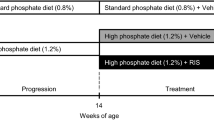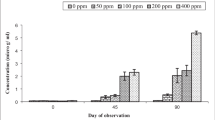Abstract
In chronic renal insufficiency (CRI), serum levels of fluoride (F–) are elevated. However, there is limited information about the effects of F– on bone in CRI. In this study, we determined whether F– content in mineralizing tissue (growth plate, cortical bone, and bone marrow of the femur) is affected by uremia. Adult rats were divided into two groups [sham-operated (S) and 5/6 nephrectomized (Nx)]. At sacrifice, the serum creatinine (mg/dl) in the S and 5/6 Nx animals was 0.37±0.09 (mean±SD) and 1.10±0.34 at 4 weeks, and 0.38±0.04 and 0.90±0.36 at 8 weeks, respectively. The serum calcium, phosphorus, and parathyroid hormone levels were lower and the serum 1, 25-dihydroxyvitamin D levels were higher in S animals than Nx animals at both 4 and 8 weeks. F– urinary excretion (ppm/24 h) was reduced in Nx animals at 4 weeks (34.0±19.2) versus S animals (50.7±12.9) (P<0.05). F– content (ppm) was significantly increased in the growth plate in Nx animals compared with S animals both at 4 weeks (550±167 vs. 353±63) and at 8 weeks (654±135 vs. 396±97), respectively (P<0.01). The F– content in cortical bone was similarly increased in Nx animals compared with S animals, but was only statistically increased at 8 weeks. There was no difference in bone marrow F– content between the two groups. In conclusion, this study suggests that in CRI, there is a rapid increase in F– content of the distal femur in the growth plate region, with a subsequent slower increase of F– content in cortical bone.
Similar content being viewed by others
Author information
Authors and Affiliations
Additional information
Received: 22 November 1999 / Revised: 7 February 2000 / Accepted: 9 February 2000
Rights and permissions
About this article
Cite this article
Mathias, R., Amin, U., Mathews, C. et al. Increased fluoride content in the femur growth plate and cortical bone of uremic rats. Pediatr Nephrol 14, 935–939 (2000). https://doi.org/10.1007/s004670000331
Issue Date:
DOI: https://doi.org/10.1007/s004670000331




